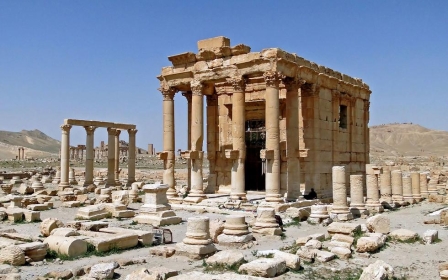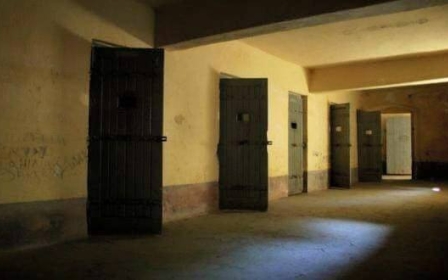Islamic State group seizes final Iraq-Syria border crossing

The Islamic State group on Friday kept up a counteroffensive that has rocked US strategy, seizing a key border crossing after capturing an Iraqi provincial capital and a renowned Syrian heritage site.
The militants, who now control roughly half of Syria, reinforced their self-declared trans-frontier state with the capture of the Al-Tanaf to Al-Walid crossing on the Damascus-Baghdad highway.
It was the last border crossing with Iraq still held by the Damascus government. Except for a short section of frontier in the north under Kurdish control, all the rest are now held by IS.
The IS surge, which has also seen the group capture Anbar capital Ramadi and the ancient Syrian city of Palmyra in the past week, comes despite eight months of US-led air strikes aimed at pushing them back.
It has sparked an exodus of tens of thousands of fearful civilians in both countries and raised fears that IS will repeat at Palmyra the destruction they have already wreaked at ancient sites in Iraq.
President Barack Obama played down the IS advance as a tactical setback and denied the US-led coalition was "losing" the battle against militancy.
But French President Francois Hollande said the world must act to stop IS and save Palmyra.
UNESCO chief Irina Bokova called the 1st and 2nd Century ruins "the birthplace of human civilisation", adding: "It belongs to the whole of humanity and I think everyone today should be worried about what is happening."
As the militants fanned out across Palmyra on Thursday, they went door to door executing suspected loyalists of the Damascus government, the Syrian Observatory for Human Rights said.
At least 17 people were killed, the Britain-based monitoring group said.
Syrian state media said loyalist troops withdrew after "a large number of IS terrorists entered the city," which lies at a strategic crossroads between Damascus and the Iraqi border to the east.
IS proclaimed Palmyra's capture online and posted video and stills footage of its fighters in the city's air base and prison, long notorious for its detention of government opponents.
The militants did not immediately post pictures of the UNESCO-listed world heritage site with its colonnaded streets, elaborately decorated tombs and temples.
IS sparked international outrage this year when it blew up the ancient Assyrian city of Nimrud in northern Iraq.
Syria's antiquities director Mamoun Abdulkarim said he feared a similar fate awaits Palmyra, and urged the world to "mobilise" to save it.
Half of Syria
IS now controls "more than 95,000 square kilometres (38,000 square miles) in Syria, which is 50 percent of the country's territory," the Observatory said.
Fabrice Balanche, a French expert on Syria, said "IS now dominates central Syria, a crossroads of primary importance" that could allow it to advance towards the capital and third city Homs.
"Taking Palmyra opens the way to Damascus and Homs. Eventually, this axis can be threatened," he said.
Matthew Henman, head of IHS Jane's Terrorism and Insurgency Centre, said the IS advance boosted its claim to be the most effective of the armed groups fighting to overthrow President Bashar al-Assad.
"It reinforces IS's position as the single opposition group that controls the most territory in Syria," he said.
The rivals of IS, Al-Qaeda affiliate Al-Nusra Front, have also been on the offensive as part of a rebel alliance that has stormed through nearly all of the north-western province of Idlib.
The rebels on Friday overran a hospital in the town of Jisr al-Shughur where at least 150 government forces and dozens of civilians were trapped for nearly a month, the Observatory said.
It said dozens managed to escape but despite a pledge from President Bashar al-Assad to rescue them, others were killed.
Palmyra's takeover came days after IS seized the Iraqi city of Ramadi, their most significant victory since their lighting advance across swathes of northern Iraq last summer.
On Thursday, IS pushed further and seized Iraqi positions east of Ramadi, officials said.
Obama blamed the "setback" in Ramadi on a lack of training and reinforcements for the city's garrison.
"I don't think we're losing," he told news magazine The Atlantic.
"The training of Iraqi security forces, the fortifications, the command-and-control systems are not happening fast enough in Anbar, in the Sunni parts of the country."
The Pentagon said Iraqi forces retreated from Ramadi partly because they incorrectly believed a sandstorm was preventing US-led aircraft from coming to their aid.
Russia said it was prepared to deliver weapons after Iraqi Prime Minister Haider al-Abadi asked for support during a visit to Moscow.
Middle East Eye propose une couverture et une analyse indépendantes et incomparables du Moyen-Orient, de l’Afrique du Nord et d’autres régions du monde. Pour en savoir plus sur la reprise de ce contenu et les frais qui s’appliquent, veuillez remplir ce formulaire [en anglais]. Pour en savoir plus sur MEE, cliquez ici [en anglais].




